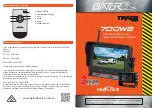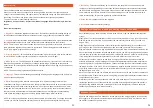
Menu structure
Press the Menu button to scroll through each menu item.
When you see the menu item that you wish to change simply press the left of right arrow key to
change it to the desired setting. The right arrow key increases the setting, the left arrow decreases
the setting. To exit the menu system simply wait 4 seconds without pressing any buttons.
The menu structure is in the following sequence.
Brightness, Contrast, Colour, Aspect ratio (Mode) ,Language, Mirror, Back Delay, Guide line,
Reset.
Menu item descriptions.
1. Brightness:
Adjusts the brightness of the screen. Be careful not to adjust this setting to high as
this will reduce the contrast (blacks will eventually become greys reducing the contrast to whites)
2. Contrast:
Adjust the transitions of highlighted areas to darkest shadows. A higher contrast makes
the image appear sharper, but to much contrast will remove subtle details in the mid tones.
NOTE: There is also a direct access button second from the right (Picture) at the base of the screen
thats adjusts the brightness and contrast to preset levels. This button toggles between settings of
Day, Night1, Night2, Night3, and User settings.
3. Colour (Saturation):
This adjusts the colour saturation. Higher levels yield more colour, however
to much colour may effect night time performance (may result in a noisy image).
4. Mode:
16:9 or 4:3. The monitor has a 16:9 aspect ratio screen so if you select 4:3 it will result in a
Black band on either side of the image by creating a square image. Depending on the cameras
aspect ration. This setting will correct aspect ration misalignment were an image may be stretched or
compressed.
NOTE: The mode setting is global and effects all cameras
5. Language:
There are 9 different language settings including popular languages such as German,
Chinese, Italian, and Spanish.
6. Mirror:
Depending on the direction of the camera you may wish to change the left to right
orientation of the image for each camera. An example of this function would be in the event you have
a forward facing camera and a rear facing camera. One of these images is best viewed as a mirror
image (the rear view) and the other as a normal view (the front facing camera). Another situation
that may need to be addressed is a camera that already has a mirror flip that is unwanted (being
used as forward facing) many cameras sold in todays market have a mirror flip built in.
NOTE: this setting only effects the currently viewed camera (not all cameras). To change the desired
camera, you must be viewing the camera you want to change when entering the menu system).
7. Back delay:
This sets the Off delay time of the AV3 wired camera. When set the monitor will
remain on for the designated amount of seconds before switching back to the previous state before
the AV3 camera was triggered. For example if the unit was off and the trigger woke the unit then the
unit will return to the off state. However if the unit was viewing one of the wireless channels it will
return to that channel. This function is global so it effects all cameras.
8. Guide line:
Only appear on AV3 when triggered
9. Reset:
Returns the unit to factory settings.
Once installed you may need to pair the Camera to the monitor, or pair an additional camera to the
system.
Step1: Select The video Channel that you wish to pair a camera with AV1 or AV2 (AV3 is wired only)
Step 2: Remove the cover screw from the back of the camera that you wish to pair (as shown on
page 6, Fig2)
Step3:Press and hold the Pair button on the monitor (bottom Right of screen) for 3 seconds until it
go's into pair mode. The screen will start a pair mode count down timer from 30 to 0 seconds.
Step 4: Within the 30 seconds, Using a small jewelers size screw driver depress the button inside the
back of the camera for at least 3 seconds (the switch is tactile, you will feel it engage when you press
it). When the monitor sees the camera in pair mode it will pair the active AV Chanel to it. After pairing
is complete please remember to replace the cover screw to protect the camera from the
environment. When the monitor is on and there is no signal present from a wireless camera the
system will display a No Signal message on the screen for approximately 30 seconds, after that the
screen will go black. If a signal on the active AV channel is sensed the unit will automatically display
the image. However, if you are on AV1 for example and a signal is received on AV2 the unit will still
only display a blank screen. In other words for both wireless channels, you have to manually select
the channel you wish to view.
Note: The system comes with one wireless camera but in fact can works with 2 wireless cameras and
a 3rd wired camera. Please refer to the main wiring diagram for details of additional cameras that are
compatible with this system.
Whilst the system has 2 wireless channels it also has a 3rd wired channel. This can be handy if you
find that the position of one of the cameras is in a position were the signal strength at the monitor is
marginal (a long distance away and or shaded by a lot of solid steel panels.) It is also a handy 3rd
channel as an addition to the wireless channels.
AV3 also has a trigger wire. This allows AV3 to take priority. When a trigger signal is received on the
AV3 trigger wire the system will automatically switch directly to AV3 as priority. It will even do this if
the monitor is switched of (vehicle is on)
P3
P4
Pairing a new Camera or re-pairing an existing camera. AV1 and AV2
Wired AV3 Channel






